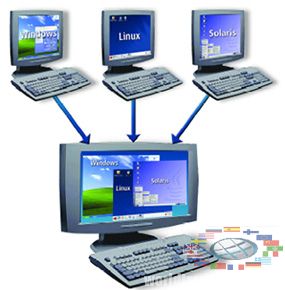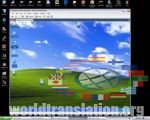Virtual operating systems

It's no secret that in addition to the Windows operating system there are more than a dozen OS. They all have their own characteristics, advantages and disadvantages. Over the past few years virtual services gained incredible popularity. In the Internet you can find virtual editors, converters, translators, and even operating systems.
 The first thing that attracts in such operating systems - the ability to store your files in a virtual environment, ie you do not longer have to worry about backing up, just remember your account. You can directly manage such operating systems from the browser without installing any additional software. Of course, as for virtual OS you need a browser you can't consider "cloud" operating system, as a complete replacement of the stationary OS , but perhaps in the near future the situation will change completely.
The first thing that attracts in such operating systems - the ability to store your files in a virtual environment, ie you do not longer have to worry about backing up, just remember your account. You can directly manage such operating systems from the browser without installing any additional software. Of course, as for virtual OS you need a browser you can't consider "cloud" operating system, as a complete replacement of the stationary OS , but perhaps in the near future the situation will change completely. eye OS (http://www. eye os.org/) is one of the first virtual operating systems, which has a rather strict design and has a set of features, which best approximate it to the normal OS. Under the Eye OS were written special programs that can be installed and removed as easily as we do this in Windows. Among the major programs the user will find a text editor, a player for audio and video playback, a notepad, a program for viewing graphics, file manager and several applications to work in social networks. As in any stationary OS, all applications open in separate windows, which allows you to run multiple programs. If you plan to work on one or more documents with another person who is located remotely then eye OS file manager can help you do this job very easy.
eye OS (http://www. eye os.org/) is one of the first virtual operating systems, which has a rather strict design and has a set of features, which best approximate it to the normal OS. Under the Eye OS were written special programs that can be installed and removed as easily as we do this in Windows. Among the major programs the user will find a text editor, a player for audio and video playback, a notepad, a program for viewing graphics, file manager and several applications to work in social networks. As in any stationary OS, all applications open in separate windows, which allows you to run multiple programs. If you plan to work on one or more documents with another person who is located remotely then eye OS file manager can help you do this job very easy.  You only need to invite someone who has an account in eye OS and mark the documents that you want to share for viewing and editing. After the user will accept your invitation, you will be able to see as his files, which he shared for you, as together view and edit any document from the lists that you have shared.
You only need to invite someone who has an account in eye OS and mark the documents that you want to share for viewing and editing. After the user will accept your invitation, you will be able to see as his files, which he shared for you, as together view and edit any document from the lists that you have shared.


 Virtual or "cloud" operating system currently are quite popular, and although it is will hardly to refuse of stationary OS, many people want to try something new, and the ability to store and edit your files remotely attracts more and more users, encouraging creators of "cloud" solutions to continue their work in this promising area.
Virtual or "cloud" operating system currently are quite popular, and although it is will hardly to refuse of stationary OS, many people want to try something new, and the ability to store and edit your files remotely attracts more and more users, encouraging creators of "cloud" solutions to continue their work in this promising area.
 In conclusion I want to say that from personal experience - now the best choice for virtualization is the products of VMware (http://www. vmware.com/): VMware Workstation, VMware Player, VMware View, VMware Server, VMware vSphere, VMware VCloud, etc. These products have great functionality, are easy to use, have a user-friendly interface and will give you an opportunity to evaluate all the features and benefits of virtual operating systems.
In conclusion I want to say that from personal experience - now the best choice for virtualization is the products of VMware (http://www. vmware.com/): VMware Workstation, VMware Player, VMware View, VMware Server, VMware vSphere, VMware VCloud, etc. These products have great functionality, are easy to use, have a user-friendly interface and will give you an opportunity to evaluate all the features and benefits of virtual operating systems.
Video: "What is Vmware Workstation?"